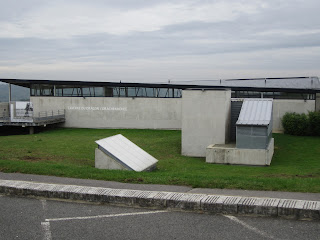This is the other bus ahead of us. I am completely in awe of how these drivers handle them through the narrow, narrow village streets - especially on the corners!
It took two hours to get to our destination. The Chemin des Dames is a road (meaning path of the women) named after two of Louis XV's daughters who used the path regularly in the 18th century. It was barely a track but because they used it so often from Paris to visit a friend living in a chateau near Vauclair, the owner, a count, had the road resurfaced for them and it gained it's name. It is famous though for a far more important reason.
Chemin des Dames formed part of the Western Front during WW1, and it's strategic importance made it the staging ground of several notable battles. The astounding thing is, that part of it is situated above a huge limestone quarry.
There are numerous war memorials and cemeteries, German, French and British, all along the chemin.
Beneath the Chemin des Dames ridge is an almost one-square-kilometre cave network called "The Dragon's Lair" (La Caverne du Dragon). The subterranean caverns originally were a tunnel system created from excavations of limestone for building purposes in the 17th century. Huge blocks were removed for the construction of cathedrals at the time. The caves are some 20–40 metres below the surface. During World War 1, the caves were used by both French and German forces as field hospitals and command posts, sometimes simultaneously.
Unfortunately cameras were not allowed, so I have no pictures to show,but this time I did find myself well below (truly below this time!) the earth's surface experiencing something I will never forget. These huge caverns were only dimly lit, and on the 'ceiling' still visible are black drawings and writing written in candle smoke by the men working in the quarry in the 1600s! As well, are messages and little maps drawn by the Germans during WW1 (they held control for the longest time), so that soldiers didn't lose their way. All sorts of memorabilia have been unearthed and there is a very realistic creation of a trench showing how the soldiers fought from them. There were helmets, guns, bullets, incendiary devices and shovels and picks used. The Germans excavated even more to make a bigger command post. Of course it was a perfect position so far below the surface with supplies etc reasonably safe. To keep the new excavations secret, the excavated limestone was packed back onto floors so that in some parts the ceiling is only 6ft 6" high. Throughout our tour, fed through a speaker system, were explosions and huge bangs, replicating what the soldiers heard for days on end. Alongside our path was a continual display of all that they had found in there after the war. There was also an incredible display in glass pedestals of artefacts found down there that soldiers had handcrafted as they sat waiting and waiting.... The intricate detail in the figurines and airplanes was amazing.

The museum above the limestone quarry - very industrial looking.
150 kids to unload off two massive buses
After we left the museum, a guide came in the bus with us and we went a few kms down the road and took a walk into the forest a bit to what was actually part of the trenches! To see it all laid out before you was amazing. Because it was freezing cold and wet made it even easier to imagine what hell the soldiers went through. It was all once farmland but it would have been too costly to return it all to arable land after the war, so the government bought it and planted it out in trees after superficially clearing it of incendiaries etc. They told us it would take hundreds of years to thoroughly clear out the limestone quarry of all that, so you are warned not to go off the designated path! There is also the remains of the old town of the nearest village further up the road. It was completely destroyed in WW1 and we could just see a big lump of stone as all that was left of the cathedral and various other bits of rock protruding through the leaves and dirt. It was amazing to be standing exactly where all that horror took place and to try and imagine what it was like.
The trenches
By 3.45pm we were on our way home again. I was frozen to the bone and couldn't even warm up in the bus. When I walked into the house, it smelt wonderful as Danielle prepared for the visitors coming for tea tomorrow night. She plonked a red wine and a religieuse in front of me saying it would warm me up! What more could a girl want?
A religieuse - choux pastry filled with chocolate custard cream - quite nice!
Entree later on was cucumber gazpacho in a little bowl to drink out of with pink peppercorns on top, along with an individual cheese fondue to dunk, guess what? Yes, bits of fresh, soft baguette into!
Pork steak, cauliflower and potatoes for main, then eclairs and religieuse for dessert! I think I've mentioned that Derek won't recognise me as I roll off the plane on Friday!
Entree tonight






Ha ha ... another great post. What a time you are having! Just wonderful to read about it all.
ReplyDelete